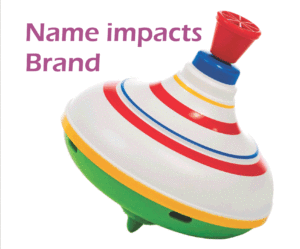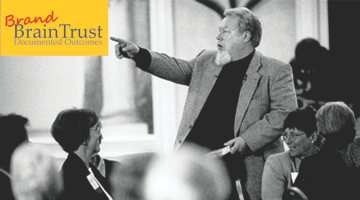 This week, the Brand Story that is front and center at Brand Brain Trust is about Jim Grew.
This week, the Brand Story that is front and center at Brand Brain Trust is about Jim Grew.
You can learn three valuable lessons by studying his Brand Success Story:
- Listen. Clients and prospects describe your brand in words that others like them understand.
- Show. Prospects want to know what you’re like and what it’s like to work with you. A video invitation and video testimonials on your web site puts them at ease.
- Tell. When you put your expertise into a book it can close the sale for you.
Full Disclosure: Jim is a client. We’ve been working together since 2012 when he decided to stop turning companies around and start consulting.
We’re getting ready to change his web site again.
Why?
Because we keep those three tips in mind.
We listen.
Jim listens to what his clients are saying and observing as he works with them building staff, approaches and analytics to transform their business. When the same phrase keeps popping up we know we have a description we can use.
I listen when I go in to capture the video testimonials. After a few minutes with my standard questions they relax enough to become quite candid often putting their words to concepts difficult to convey until they give us a way.
We show.
Jim’s web site is upgraded at least once a year, overall. The relevant testimonials and invitations to his services change as we come to understand the reasons most business owners are interested and the information they are looking for in order to make a decision.
I’ve rewritten every page of his sites multiple times in order to make it easier for prospects to begin connecting before they make a call. And we never forget that the objective is to generate positive observations that verify Jim’s qualifications and make it easy to get in touch.
We Tell.
Jim is better at consulting than he is at selling. So part of what we work on continually is 30-Second Marketing, the ability to have a conversation instead of doing a commercial. Not long ago, one of his clients used Jim’s positioning line (Business Defogger and Accelerator) in a presentation at a national convention about how Jim had helped to build his business to its greatest heights ever. The President of the largest company in the audience asked him after, “How do I get hold of this Defogger?”
That told me that the need for his services is not restricted to the Pacific Northwest. Now all I have to do is figure out how to tell all those potential clients!
_____________________________________________________________________
Jerry Fletcher is the founder and Grand Poobah of www.BrandBrainTrust.com
His consulting practice, founded in 1990, is known for Brand Development, Positioning and business development on and off-line.
Consulting: www.JerryFletcher.com
Speaking: www.NetworkingNinja.com
Get all the Brand Success Stories.
Sign up at http://www.brandbraintrust.com/home.html




